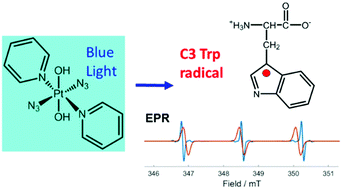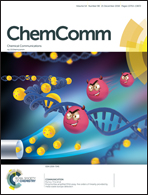Photoactivatable platinum anticancer complex can generate tryptophan radicals†
Abstract
L-Tryptophan (Trp), melatonin (MLT) and the Trp-peptide pentagastrin quenched the formation of azidyl radicals generated on irradiation of the anticancer complex trans,trans,trans-[Pt(pyridine)2(N3)2(OH)2] with visible light, giving rise to C3-centred indole radicals which were characterized for Trp and MLT using an EPR spin-trap; indole, together with azidyl and hydroxyl radicals, have potential roles in a multitargeting mechanism of action against resistant cancers.



 Please wait while we load your content...
Please wait while we load your content...